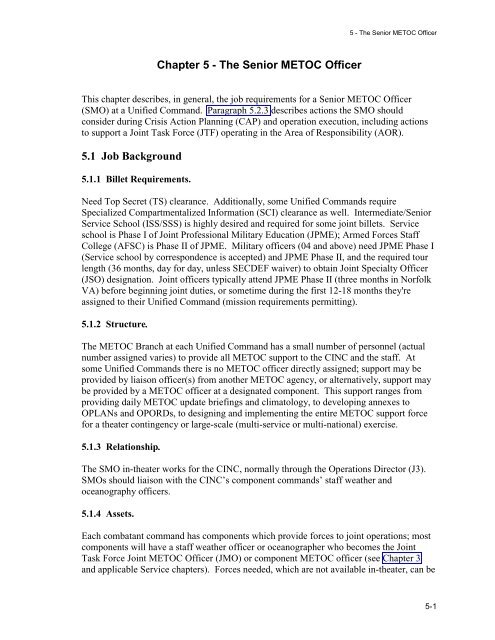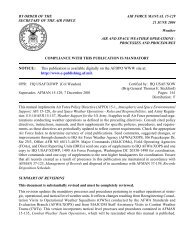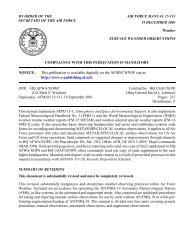Joint Metoc Handboo - IHMC Ontology and Policy Management
Joint Metoc Handboo - IHMC Ontology and Policy Management
Joint Metoc Handboo - IHMC Ontology and Policy Management
Create successful ePaper yourself
Turn your PDF publications into a flip-book with our unique Google optimized e-Paper software.
5 - The Senior METOC Officer<br />
Chapter 5 - The Senior METOC Officer<br />
This chapter describes, in general, the job requirements for a Senior METOC Officer<br />
(SMO) at a Unified Comm<strong>and</strong>. Paragraph 5.2.3 describes actions the SMO should<br />
consider during Crisis Action Planning (CAP) <strong>and</strong> operation execution, including actions<br />
to support a <strong>Joint</strong> Task Force (JTF) operating in the Area of Responsibility (AOR).<br />
5.1 Job Background<br />
5.1.1 Billet Requirements.<br />
Need Top Secret (TS) clearance. Additionally, some Unified Comm<strong>and</strong>s require<br />
Specialized Compartmentalized Information (SCI) clearance as well. Intermediate/Senior<br />
Service School (ISS/SSS) is highly desired <strong>and</strong> required for some joint billets. Service<br />
school is Phase I of <strong>Joint</strong> Professional Military Education (JPME); Armed Forces Staff<br />
College (AFSC) is Phase II of JPME. Military officers (04 <strong>and</strong> above) need JPME Phase I<br />
(Service school by correspondence is accepted) <strong>and</strong> JPME Phase II, <strong>and</strong> the required tour<br />
length (36 months, day for day, unless SECDEF waiver) to obtain <strong>Joint</strong> Specialty Officer<br />
(JSO) designation. <strong>Joint</strong> officers typically attend JPME Phase II (three months in Norfolk<br />
VA) before beginning joint duties, or sometime during the first 12-18 months they're<br />
assigned to their Unified Comm<strong>and</strong> (mission requirements permitting).<br />
5.1.2 Structure.<br />
The METOC Branch at each Unified Comm<strong>and</strong> has a small number of personnel (actual<br />
number assigned varies) to provide all METOC support to the CINC <strong>and</strong> the staff. At<br />
some Unified Comm<strong>and</strong>s there is no METOC officer directly assigned; support may be<br />
provided by liaison officer(s) from another METOC agency, or alternatively, support may<br />
be provided by a METOC officer at a designated component. This support ranges from<br />
providing daily METOC update briefings <strong>and</strong> climatology, to developing annexes to<br />
OPLANs <strong>and</strong> OPORDs, to designing <strong>and</strong> implementing the entire METOC support force<br />
for a theater contingency or large-scale (multi-service or multi-national) exercise.<br />
5.1.3 Relationship.<br />
The SMO in-theater works for the CINC, normally through the Operations Director (J3).<br />
SMOs should liaison with the CINC’s component comm<strong>and</strong>s’ staff weather <strong>and</strong><br />
oceanography officers.<br />
5.1.4 Assets.<br />
Each combatant comm<strong>and</strong> has components which provide forces to joint operations; most<br />
components will have a staff weather officer or oceanographer who becomes the <strong>Joint</strong><br />
Task Force <strong>Joint</strong> METOC Officer (JMO) or component METOC officer (see Chapter 3<br />
<strong>and</strong> applicable Service chapters). Forces needed, which are not available in-theater, can be<br />
5-1




